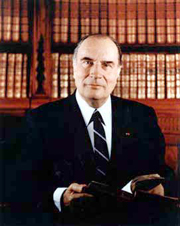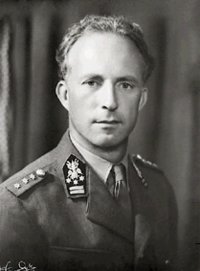Head of state
|
|
Though a term originally coined for Republican presidents, a head of state or chief of state is now universally known as the chief public representative of a nation-state, federation or commonwealth, whose role generally includes personifying the continuity and legitimacy of the state and exercising the political powers, functions and duties granted to the head of state in the country's constitution.
In Charles de Gaulle's words, describing the role he envisaged for the French president when he wrote the modern French constitution, a head of state should embody "the spirit of the nation" to the nation itself and to the world: une certaine idée de la France (a certain idea about what France is).
In a monarchy, the monarch is now deemed as the head of state. This is a relatively recent phenomenon; until the last few decades a sovereign was seen as the personal embodiment of the state, and therefore could not be head of themselves (hence the Canadian and U.K. constitutions make no mention of a "head of state"). Though some still maintain that calling a monarch head of state is incorrect, it has none-the-less become more and more fashionable to attach the label to monarchs.
In a republic, the head of state is usually called the president, although some leaders have assumed other titles (See "titles" below), and some have simply used 'Head of State' as their only formal title.
| Contents |
Presidential systems
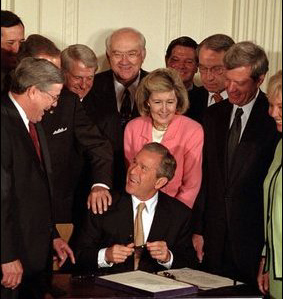
Note - 'presidential' in this context does not automatically imply a president but simply a head of state, whether elected, hereditary or dictatorial who 'presides'.
Different countries have different executive systems but in reality four general categories can be said to exist. Some constitutions or fundamental laws provide for a head of state who is not just in theory but in practice chief executive, operating separately from, and independent from, the legislature. This system is sometimes known as a presidential system because the government is answerable solely and exclusively to a 'presiding' activist head of state, and is selected by and on occasion dismissed by the head of state without reference to the legislature. It is notable that some presidential systems, while not providing for collective executive answerability to the legislature, may require legislative approval for individuals prior to their assumption of cabinet office and empower the legislature to remove a president from office (for example, in the United States). In this case the debate centres on the suitability of the individual for office, not a judgment on them when appointed, and does not involve the power to reject or approve proposed cabinet members en bloc so it is not answerability in the sense understood in a parliamentary system.
Some presidential systems may also include a prime minister but as with the other ministers they are responsible to the President, not the legislature. In many such instances the office is of minimal political importance, sometimes even held by some administrative technocrat rather than a politician. A prime minister in a presidential system lacks the constitutional and political dominance of a prime minister in a parliamentary system and is often seen as simply a politically junior figure who may run the mechanics of government while allowing the President to set the broad national agenda. One could say that, whereas in parliamentary systems a prime minister may be master of his or her party and the government, prime ministers in presidential systems are usually the servants, with the head of state the master of the government who can hire and fire anyone, including the prime minister, at will.
Presidential Systems of Governments are a notable feature of constitutions in the Americas, notably the United States. Though most presidents in the system are selected by democratic means (popular direct or indirect election, etc) the system also encompasses people who become head of state by other means, notably through military dictatorship or coup d'état. Some of the characteristics of a presidential system (ie, a strong dominant political figure with an executive answerable to them, not the legislature) can also be found among absolute monarchies.
It is worth noting that modern presidential systems, most notably the United States, owe their origins to the contemporary eighteenth century British constitutional model in existence at the time of the enactment of the Constitution of the United States, in which the British monarch was still the dominant force and their government was not in a modern sense answerable to the legislature. Thus modern presidential systems are the lineal successors of the ancien regime governmental systems of eighteenth century Europe, whereas in Europe many states have evolved from a head of state-centred executive system (a presidential system) to a legislature-orientated one (a parliamentary system). In the 1870s in the United States in the aftermath of the impeachment of President Andrew Johnson and his near removal from office it was speculated that the United States too would move from a presidential system to a semi-presidential or even parliamentary one, with the Speaker of the House of Representatives becoming the real centre of government as a quasi-prime minister. This did not happen and the presidency, having been damaged by two late nineteenth century assassinations (Lincoln and Garfield) and one impeachment (Johnson), reasserted its political dominance by the early twentieth century through such figures as Theodore Roosevelt and Woodrow Wilson.
Semi-presidential systems
Semi-presidential systems combine features of Presidential and Parliamentary systems, notably a requirement that the government be answerable to both the President and the legislature. The Constitution of the current French Fifth Republic provides for a prime minister who is chosen by the President but who nevertheless must be able to gain support in the Chamber of Deputies. Where in France a president is of one side of the political spectrum and the opposition is in control of the legislature, s/he often is forced to select someone from the opposition to become prime minister, a process known as Cohabitation. President François Mitterrand, a socialist, for example was forced to co-habit with the neo-gaullist (right wing) Jacques Chirac, who became his prime minister for a time in the 1980s.
In the French system, in the event of co-habitation, the President is often allowed to set the policy agenda in foreign affairs and the Prime Minister run the domestic agenda.
Other countries evolve into something akin to a semi-presidential system or indeed a full presidential system. Weimar Germany, for example, in its constitution provided for a popularly elected president with theoretically dominant emergency powers that were only intended to be exercised in emergencies and a cabinet appointed by him from the Reichstag which was expected in normal circumstances to be answerable to the Reichstag. Initially the President was merely a symbolic figure with the Reichstag dominant.
However longterm political instability (where governments were collapsing every couple of months) led to a change in the power structure of the Republic, with the President's emergency powers called increasingly into use to prop up governments challenged by critical or even hostile Reichstag votes. By 1932, power had shifted to such an extent that the German President, Paul von Hindenburg was able to dismiss a chancellor and select his own person for the job even though the outgoing chancellor possessed the confidence in the Reichstag while the new chancellor did not. Subsequently President von Hindenburg used his power to appoint Adolf Hitler as Reich chancellor without consulting the Reichstag.
Parliamentary systems' heads of state
KingJuanCarlosI.jpg
In parliamentary systems the head of state may be merely the nominal chief executive officer of the state, possessing theoretical executive power (hence the description of the United Kingdom monarch's government as Her Majesty's Government, a term indicating that the government is theoretically hers, not parliament's). In reality, however, due to a process of constitutional evolution powers are usually exercised by a cabinet, presided over by a prime minister or President of the Government who is answerable to parliament. This answerability requires that someone be chosen from parliament who has parliament's support (or at least not parliament's opposition - a subtle but important difference). It also gives parliament the right to vote down the government, forcing it either to resign or seek a parliamentary dissolution. Governments are thus said to be responsible (ie, answerable) to parliament, with the government, in turn, accepting constitutional responsibility for offering constitutional Advice to the head of state.
In reality, numerous variants exist to the position of a head of state within a parliamentary system. The older the constitution, the more constitutional leeway may exist for a head of state to exercise greater powers over government, as many older parliamentary system constitutions, in fact, give heads of state powers and functions akin to presidential or semi-presidential systems, in some cases without containing reference to modern democratic principles of accountability to parliament or even to modern governmental offices. For example, the 1848 constitution of the Kingdom of Italy was sufficiently ambiguous and outdated to give King Victor Emmanuel III leeway to appoint Benito Mussolini to power in controversial circumstances.
Some Commonwealth parliamentary systems combine a body of written constitutional law, unwritten constitutional precedent, Orders-in-Council, letters patent, etc. that may give a head of state or their representative additional powers in unexpected circumstances (eg, the dismissal of the Australian prime minister, Gough Whitlam by Governor-General Sir John Kerr.)
Other examples of heads of state in parliamentary systems using greater powers than normal due either too ambiguous constitutions or unprecedented national emergencies, such as King Leopold III of the Belgians's decision to surrender on behalf of his state to the invading German army in 1940, against the will of His Government. Judging that his responsibility to the nation by his coronation oath required him to act, he believed that His Government's decision to fight rather than surrender was mistaken and would damage Belgium. (Leopold's decision proved highly controversial. After World War II, Belgium voted on whether to allow him back on the throne. It did so, but because of the ongoing controversy, he ultimately abdicated the throne.)
Non-executive heads of state
Marymca.jpg
A final category of head of state which could be loosely called the non-executive head of state model also exists. Its holders are excluded completely from the executive. In other words they do not possess even theoretical executive powers or any role, even formal, within the government. Hence their states' governments are not referred to by the traditional parliamentary model head of state styles of His/Her Majesty's Government or His/Her Excellency's Government. Within this general category, variants in terms of powers and functions may exist. The King of Sweden, since the passage of the modern Swedish constitution, the Instrument of Government in the mid 1970s, no longer has any of the parliamentary system head of state functions that had previously belonged to Swedish kings. But he still receives formal cabinet briefings monthly in the Royal Palace. In contrast the only contact the Irish president has with the Irish government is through a formal briefing session given by the Taoiseach (prime minister) to the President. However she has no access to documentation and all access to ministers goes through the Department of An Taoiseach (prime minister's office).
Examples of this category invariably date from the twentieth century.
The most notable examples of this category are the
- President of Ireland
- King of Sweden (since 1975)
- President of the Federal Republic of Germany.
- Emperor of Japan
Complexities with categorisation
While clear categories do exist, it is sometimes difficult to choose which category some individual heads of state belong to. Constitutional change in Liechtenstein in 2003 gave its head of state, the Prince, unprecedented constitutional powers including a veto over legislation and power in theory to dismiss the cabinet. It could be argued that the strengthening of the Prince's powers vis-a-vis the legislature has moved Liechtenstein in the semi-presidential category. Similarly the original powers given to the Greek President of the Republic under the 1974 Hellenic Republic constitution made Greece more akin to the French semi-presidential model. And the theoretical power of the British monarch to dismiss their government at will would suggest that the United Kingdom should belong to the semi-presidential category also. In reality the category to which each head of stateship belongs is assessed not by theory but by practice. In practice no British monarch has forced a government from office since the early nineteenth century, while the Greek Republic in reality even before the powers of the President of the Republic were curtailed operated as a standard parliamentary system. Unless and until a Prince of Liechtenstein exercises the theoretical powers they now possess, the principality would still remain categorised as a parliamentary system.
Roles of the head of state
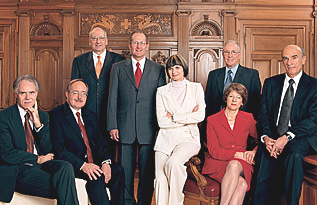
Depending on which category (above) a head of state belongs to, they may have some or all of the roles listed below.
Chief diplomatic officer
- The head of state accredits his or her country's ambassadors, through sending formal Letters of Credence to other heads of state. Without that accreditation, ipso facto an ambassador does not take up a role and receive diplomatic status.
- He or she receives Letters of Credence, sent by other heads of state accrediting his/her ambassador to the state.
- He or she signs international treaties on behalf of the state, or has them signed in his/her name by ministers.
- Example: under the Basic Law of the Federal Republic of Germany (constitution), Article 59 (1) states -
- The Federal President shall represent the Federation in its international relations. He shall conclude treaties with foreign states on behalf of the Federation. He shall accredit and receive envoys.
- Example: under the Basic Law of the Federal Republic of Germany (constitution), Article 59 (1) states -
Chief executive officer
In the vast majority of states, whether republics or monarchies, executive authority is vested, at least notionally, in the head of state. In presidential systems the head of state is the actual, de facto chief executive officer. Under parliamentary systems the executive authority is theoretically exercised by the head of state but in practice exercised on the advice of the prime minister or cabinet. This produces such terms as Her Majesty's Government and His Excellency's Government. Examples of parliamentary systems in which the head of state is notional chief executive include Australia, Austria, Canada, Denmark, France, Italy and the United Kingdom. The few exceptions include the Republic of Ireland, where executive authority is explicitly vested in the cabinet, and Sweden. The head of state may also be described, although, again, in parliamentary systems this is only a notional designation, as commander-in-chief of the armed forces.
- Example 1 (presidential system): Article 2, Section 1 of the United States Constitution states:
- The executive Power shall be vested in a President of the United States of America.
- Example 1 (presidential system): Article 2, Section 1 of the United States Constitution states:
- Example 2 (Victorian era constitutional monarchy): Under Chapter II, Section 61 of the Commonwealth of Australia Constitution Act, 1900:
- The executive power of the Commonwealth is vested in the Queen and is exercisable by the Governor-General as the Queen's representative, and extends to the execution and maintenance of this Constitution, and of the laws of the Commonwealth.
- Example 2 (Victorian era constitutional monarchy): Under Chapter II, Section 61 of the Commonwealth of Australia Constitution Act, 1900:
- Example 3 (mid-20th century constitutional monarchy): According to Section 12 of the Constitution of Denmark 1953:
- Subject to the limitations laid down in this Constitution Act the King shall have the supreme authority in all the affairs of the Realm, and he shall exercise such supreme authority through the Ministers.
- Example 3 (mid-20th century constitutional monarchy): According to Section 12 of the Constitution of Denmark 1953:
- Example 4 (modern republican parliamentary system): According to Article 26 (2) of the 1975 Constitution of Greece:
- The executive power shall be exercised by the President of the Republic and by the government.
- Example 4 (modern republican parliamentary system): According to Article 26 (2) of the 1975 Constitution of Greece:
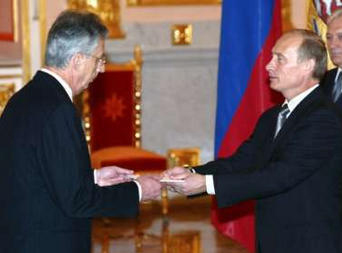
Chief appointments officer
- He or she appoints all the key officials in the state, including members of the cabinet, the prime minister (if there is one), key judicial figures and all major office holders. In most parliamentary systems the prime minister is appointed with the consent of the legislature, and other figures are appointed on the prime minister's advice. Some countries have exceptions - under Article 4 of the Instrument of Government 1974, the constitution of Sweden grants to the parliamentary speaker the role of formally appointing the prime minister. In practice, this decision is often a formality. The last time a United Kingdom monarch actually had a choice over who to pick to be prime minister occurred in 1963, when Queen Elizabeth II chose Alec Douglas-Home to succeed Harold Macmillan. In presidential systems such as that of the United States, appointments are nominated by the president's sole discretion, and this nomination if often subject to parliamentary confirmation (in the case of the U.S., the U.S. Senate has to approve cabinet nominees and judicial appointments by simple majority).
- He or she may dismiss office-holders. In parliamentary systems, this is only done on the binding advice of another office-holder; for example, members of the Irish cabinet are dismissed by the President of Ireland on the advice of the Taoiseach (prime minister). In some instances, the head of state may be able to dismiss an office holder themselves. Many heads of state or their representatives have the theoretical power to dismiss any office-holder while it is exceptionally rarely used. Its use is sometimes controversial, such as when the Australian Governor-General dismissed the prime minister during the 1975 Australian Constitutional Crisis. In France, while the president cannot force the prime minister to tender the resignation of his government, he in practice can request it if the prime minister is from his own majority. In presidential systems, the president often has the power to fire ministers at his sole discretion. In the U.S., convention calls for cabinet secretaries to resign on their own initiative when called to do so.
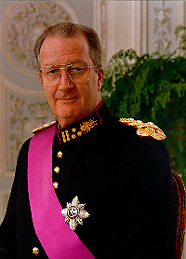
- Example 1 (semi-presidential system): Chapter 4, Section 2 of the Constitution of the Republic of Korea states:
- The Prime Minister is appointed by the President with the consent of the National Assembly.
- Example 2 (parliamentary system): Article 13.1.1 of the Constitution of Ireland:
- The President shall, on the nomination of Dáil Éireann [the lower house], appoint the Taoiseach [prime minister].
- Example 1 (semi-presidential system): Chapter 4, Section 2 of the Constitution of the Republic of Korea states:
Signing bills into law
Most states require that all bills passed by the house or houses of the legislature are signed into law by the head of state. In some states, such as the United Kingdom and the Republic of Ireland, the head of state is in fact formally considered a tier of parliament. In presidential systems the head of state often has power to veto a bill. In most parliamentary systems, however, the head of state cannot refuse to sign a bill, but may, in granting a bill their assent, nevertheless indicate that it was passed in accordance with the correct procedures. The signing of a bill into law is formally known as promulgation. Some Commonwealth of Nations states call this procedure granting the Royal Assent.
- Example 1 (presidential system): Article 1, Section 7 of the United States Constitution states:
- Every Bill which shall have passed the House of Representatives and the Senate, shall, before it become a Law, be presented to the President of the United States.
- Example 2 (parliamentary system): Section 11.a.1. of the Basic Laws of Israel states:
- The President of the State shall sign every Law, other than a Law relating to its powers.
- Example 1 (presidential system): Article 1, Section 7 of the United States Constitution states:
In some parliamentary systems the head of state retains certain powers, in relation to bills, that they may exercise at their discretion. They may have authority to:
- Veto a bill until the houses of the legislature have reconsidered it, and approved it a second time.
- Reserve a bill to be signed later, or suspend it indefinitely (generally in states with the Royal Prerogative; this power is rarely is used).
- Refer a bill to the courts to test its constitutionality (e.g. the President of Ireland)
- Refer a bill to the people in a referendum (e.g. the President of Ireland may do so in certain circumstances).
Supreme commander of the military
- A head of state is generally the notional or literal commander-in-chief of a state's armed forces, holding the highest office in all military chains of command.
Example: Article II, Section 2 of the United States Constitution states:
- The President shall be Commander in Chief of the Army and Navy of the United States, and of the Militia of the several States, when called into the actual Service of the United States.
- In military dictatorships, or governments which have arisen from coups-de-état, this position is obvious, as all authority in such a government derives from the application of military force.
Summoning and dissolving the legislature
- A head of state is often empowered to summon and dissolve the legislature. In most parliamentary systems, this is done on the advice of the prime minister or cabinet. In some parliamentary systems, and in some presidential systems, the head of state may on their own initiative do so. Some states, however, have fixed term parliaments, with no option of bringing forward elections (e.g. Article II, Section 3, of the U.S. Constitution). In other systems there are fixed terms, but the head of state retains authority to dissolve the legislature in certain circumstances. Where a prime minister has lost the confidence of parliament, some states allow the head of state to refuse a parliamentary dissolution, where one is requested, forcing the prime minister's resignation.
- Example: Article 13.2.2. of the Constitution of Ireland states:
- The President may in absolute discretion refuse to dissolve Dáil Éireann on the advice of a Taoiseach [prime minister] who has ceased to retain the support of a majority in Dáil Éireann
- Example: Article 13.2.2. of the Constitution of Ireland states:
Symbolic role
As the above quote by Charles de Gaulle indicates, one of the most important roles of the modern head of state is being a symbolic national symbol of the nation.
In most countries portraits of the head of state can be found in government offices, airports, libraries, and other buildings of the sort. The idea is to use these portraits to make the public aware of the symbolic connection to the government, a practice that dates back to mediaeval times. Sometimes this practice is taken to excess, and the head of state begins to believe that he is the only symbol of the nation. A personality cult thus ensues, where the image of the head of state is the only visual representation of the country, surpassing other symbols such as the flag, constitution, founding fathers, etc.
In diplomatic affairs, heads of state are often the first person to greet an important foreign visitor. They may also assume a sort of informal "host" role during the VIP's visit, inviting the visitor to a state dinner at his or her mansion or palace, or some other equally hospitable affair.
Selection of heads of state

A heads of state may acquire their position in a number of ways:
- The position of a monarch is usually hereditary. There are rare exceptions to this, such as the Pope.
- The head of state of a republic is usually elected, either:
- Directly: through popular election.
- Indirectly: by members of the legislature or of a special college of electors.
- A head of state who is an authoritarian ruler may seize power. Dictators often use democratic titles, though some proclaim themselves monarchs. Examples of the latter include Emperor Napoleon III of France and King Zog of Albania. Francisco Franco, who adopted the formal title Jefe del Estado, or Chief of State, and established himself as regent for a vacant monarchy. Idi Amin made himself President for Life, and Kim Jong Il of North Korea is styled "the Dear Leader."
Governors-general
In some cases, where one person is head of state of multiple countries, they may be represented by a governor-general. Examples are Canada, Australia and New Zealand, where the monarch, Queen Elizabeth II, resides in another of her kingdoms, the United Kingdom, and so is represented by a governor-general. The 16 member-states of the Commonwealth of Nations which have Queen Elizabeth II as Sovereign, including the United Kingdom, are known as Commonwealth Realms.
The Governor-General may fulfill many of the roles of a head of state, but is not legally the head of state, rather an appointed representative of the head of state that may act in her place in her absence from the state. A governor-general may be considered de facto head of state as the monarch rarely exercises the reserve powers of the crown. In some Commonwealth Realms such as Australia and Canada, the Governor-General is recognised as the de facto head of state and may, arguably by the de jure head of state. See, for example, the Queen of Canada .
In diplomatic situations, governors-general are often accorded the full status and privileges of a head of state.
Titles
Along with President, King, and Queen, a few Heads of State use different titles.
| Country | Title |
|---|---|
| Kuwait, Qatar | Emir |
| Japan | Emperor |
| Liechtenstein, Monaco | Prince |
| Luxembourg | Grand Duke |
| Vatican | Pope |
| San Marino | Captain Regent |
| Oman | Sultan | The Netherlands (historical) | stadholder |
There are also a few nations in which the exact title and definition of the office of Head of State is vague. These include Kim Jong Il in North Korea and Ali Khamenei of Iran (the Supreme Leader).
The Emperor (Tennō) of Japan is defined as a symbol, not head, of state by the post-war constitution.
Statistics
- World's longest serving current Head of State: King Rama IX of Thailand (since 1946)
- World's longest serving current republican Head of State: President Fidel Castro of Cuba (since 1976)
- Nations with multiple people as Head of State: Switzerland (seven-member Federal Council); San Marino (two "Captains-regent"); Andorra (president of France and bishop of Urgell, Spain, co-princes); Bosnia and Herzegovina (three member presidency, from three different nations).
- Person who serves as Head of State in the most nations: Queen Elizabeth II serves as Head of State in 16 different independent countries.
Official residences
Every head of state is provided with a state residence or residences, often called a 'palace'. Among the most famous such residences are:
- Old Royal Palace - President of Serbia
- Palácio de Belém - President of Portugal
- Áras an Uachtaráin - President of Ireland
- Bellevue Palace - Federal President of Germany
- Blue House - President of South Korea
- Buckingham Palace - Queen of the United Kingdom
- Casa Rosada - President of Argentina
- Élysée Palace - President of the French Republic
- Hofburg Imperial Palace - Austrian Federal President
- Kokyo - Emperor of Japan
- Los Pinos - President of Mexico
- Kremlin - President of Russia
- Palacio Real de Madrid - King of Spain
- Vatican Palace - Pope
- Quirinal Palace - President of the Italian Republic
- Rashtrapati Bhavan - President of India
- White House - President of the United States
- Malacanang Palace - President of the Philippines
- Government House is a generic term used for gubernatorial residences in many nations. For example, the Governor-General of Australia resides in Government House, Canberra. However, the Governor General of Canada is an exception, as his or her primary residence is Rideau Hall. Declarations printed in the Canada Gazette by the Governor General of Canada are nonetheless given the title Government House. However the residence of the first and second Governors-General of the Irish Free State was known as the Viceregal Lodge, the building's name under the preceding Representative of the Crown, the Lords Lieutenant of Ireland. (The building, which is now the residence of the President of Ireland, is now called Áras an Uachtaráin).
See also
- Governor-General
- Head of government
- Heads of state timeline
- List of national leaders
- List of official residences
- Monarch
- President
- Prime Ministerda:Statsoverhoved
de:Staatsoberhaupt es:Jefe de Estado eo:Ŝtatestro he:ראש מדינה li:Sjtaotshouf nl:Staatshoofd ja:元首 no:Statssjef pl:Głowa państwa pt:Chefe de Estado simple:Head of state sv:Statschef tr:Devlet başkanı zh:國家元首 zh-min-nan:Kok-ka ê thâu-lâng

